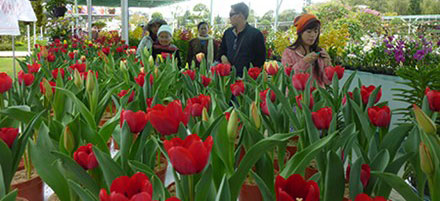(CPV) - Vietnam’s fresh flowers are known among international friends through the Da Lat Flower Festival, and they are now being exported to many countries around the world.
Apart from paying attention to production, preserving and developing a suitable distribution system, Vietnam’s fresh flower exporters are finding ways to affirm their position on the international market.
Great potential but limited export
According to the Ministry of Industry and Trade (MoIT), Vietnam’s main flower export markets are now China, Japan, Singapore, Australia and Saudi Arabia.
 |
|
Photo for illustration - Source: laodong.com.vn |
Flower export from Southeast Asian countries in general and Vietnam in particular usually has difficulty penetrating North America and Western Europe, because these two markets mainly import flowers from South America, Central America and Southern European countries. In addition to the rigorous technical factors, the geographical location resulting in high transport cost also challenges Vietnam's flower exports.
The Trade Promotion Department under the MoIT announced that in the Japanese market, Vietnam’s fresh flowers are popular, especially lotus flowers. Japan consumers require high quality and customs procedures are strict, but successfully imported flowers go for high prices, so this market has attracted many flower importers.
Netherlands is the power of flowers in the world, with annual flower export revenue at high levels compared to other EU countries. The country not only grows fresh flowers for export, but also imports large amounts of fresh flowers from other countries to export.
Flowers from developing countries imported to the EU via the Netherlands are not taxed, thus creating favourable conditions for developing countries including Vietnam to penetrate the market.
In China, flowers from Da Lat such as rose, lily and orchid are very popular. According to the experience of China, the demand for flowers before and after the Lunar New Year is huge because of the many festivals during this time. Moreover, China’s weather is unfavourable for planting and harvesting flowers.
In Vietnam, Da Lat city has the largest area for growing and exporting flowers in the country, with 3,500ha, accounting for 40% of the area and 50% of the output of the country. Each year, the city supplies the domestic market and exports about 10 million fresh flowers.
However, according to the Da Lat Flower Association, the area and annual yields of the city continue to increase every year but the export yield remains the same. The main flower exporter in Da Lat is Dalat Hasfarm. Other companies had exported shipments of flowers, such as Dai Viet, Rung Hoa, Thai Son, Langbiangfarm and Ngoc Mai Trang, but they have failed.
The main reason is small-scale, spontaneous and fragmented production, as well as the quality of flowers is not improved compared to decades ago.
In addition, when the businesses get large orders from the partners, they often can’t control the quality and prices of flowers because they themselves only provide 50-60% of flowers to meet the orders.
Expanding export market
In 2010, Vietnam’s area of fresh flowers was about 8.000 ha with 4.5 billion branches, of which 1 billion branches were exported, of which 85% were roses, chrysanthemums and orchids. The revenue from flower export reached USD60 million.
Vietnam’s production of fresh flowers is concentrated in big cities such as Hanoi, Hai Phong and Lam Dong. Lao Cai province’s Sapa town has the potential to grow flowers for export because the cold climate, but it is small scale.
The Central region begins to produce flowers, but mainly serves the local market. The southern provinces also concentrate in flower production but mainly tropical flowers.
According to the MoIT, the target of Vietnam's flower export in the coming time will be to extend existing markets in Asia because advantages of the market is close geographical distance, low transportation costs and easy preservation and find new customers based on existing commercial relationships. The long-term goal is to grow into the markets of North American countries such as Canada, the US and Central European countries.
In addition, to develop the fresh flower market, the growers should implement necessary development policies such as applying advanced science and technology in all aspects of production, trade promotion and selling in order to improve productivity and quality of flowers and reduce production costs.
At the same time, a legal framework suitable with the international technical standards should be established as well as continue to diversify flowers appropriate with conditions of geography, climate and market of each type of flower./.